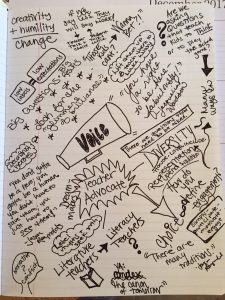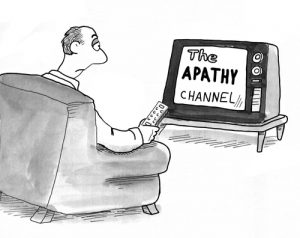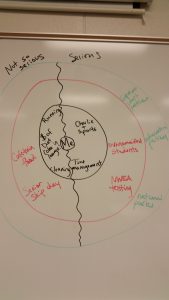
While I watched the Women’s Moguls event during the Olympics, an Australian skier had a particularly bumpy performance (insert groan here), blasting through the orange flags. Yet as she stopped at the finish line, she gestured “oh well” with an unflappable grace, adjusted her goggles, and gave the camera a thumbs up.
So, how do we get our student to respond to failure like Olympians?
Model Live, Unprepared Writing
Imagine my fear when I wrote live in front of my middle school students for the first time. It felt like a daring move in my first year of teaching–to share raw writing with a crowd of thirteen-year-olds. Yet, to my surprise, these students were completely tuned into what I needed as a writer.
When I modeled, students were quick to throw out a word, phrase, or question that prompted me when I was stuck. I scribbled all over the overhead. There was a tremble as I wrote those first few times, and it was a tremble that showed my students that writing has fits of balance and chaos.
In being open to moments where I choked out words, I was able to show my students how a writer gets back up after tripping over words and how a supportive writing community can move a writer.
Resist the Urge to “Red Pen” Their Writing
The godfather of the writing process, Donald Murray, says that the standard approach to teaching writing is a form of “repetitive autopsying,” one that “doesn’t give birth to live writing.” For Murray, live writing is authentic and process based. It allows for growth.
The red pen, on the other hand, leads a student to identify as a poor writer rather than a developing writer–even though writing only gets better when students can take risks and not fear a punishing grade or comment.
Moving away from a deficit model of teaching, then, leads students to not fear feedback from their teachers and peers.
Provide Empathetic Feedback
What can help our students to get back up after a fall? The place to start is to help them recognize that all writers will hit a bumpy stretch at some point in the writing process.
For many students, this vulnerability is scary and paralyzing. And it’s even worse when the feedback is given postmortem–after they submit a composition for a grade. Yet, it’s those moments of moments of vulnerability, Brené Brown reminds us, that can lead a student to deep learning.
One solution is to offer multiple times to confer with a student in a low-stakes way. No grades. No red pen. Just a conversation between teacher and student. This formative feedback is essential to their growth.
All students will find an aspect of the process challenging–make that transparent to them. They will try ideas that may not work. They may delete passages that took time to compose. And they may feel a deep sense of frustration and tell themselves that they are not a “good writer.”
But always bear in mind how challenging writing can be.
When we really know the writer, and we know how much effort has gone into their writing, we will know how to respond generously. We will know that recognizing the strength in the risk they took as a writer will eventually lead them to growth.
 Lauren Nizol (@CoachNizol) is an MTSS Student Support Coach and Interventionist at Novi High School. She has eleven years of classroom experience, teaching English, IB Theory of Knowledge and English Lab. Lauren completed her undergraduate degree in History, English and Secondary Education at the University of Michigan-Dearborn and her Masters in English Education from Eastern Michigan University. She is a National Writing Project Teacher Consultant with the Eastern Michigan Writing Project and an advocate for underperforming students and literacy interventions. When she’s not teaching, Lauren often runs for the woods with her husband and their three sons/Jedi in training and posts many stylized pictures of trees on Instagram.
Lauren Nizol (@CoachNizol) is an MTSS Student Support Coach and Interventionist at Novi High School. She has eleven years of classroom experience, teaching English, IB Theory of Knowledge and English Lab. Lauren completed her undergraduate degree in History, English and Secondary Education at the University of Michigan-Dearborn and her Masters in English Education from Eastern Michigan University. She is a National Writing Project Teacher Consultant with the Eastern Michigan Writing Project and an advocate for underperforming students and literacy interventions. When she’s not teaching, Lauren often runs for the woods with her husband and their three sons/Jedi in training and posts many stylized pictures of trees on Instagram.



 Megan Kortlandt
Megan Kortlandt “Just give me a topic. I’ll write about anything. I don’t care.”
“Just give me a topic. I’ll write about anything. I don’t care.”

 At the start of school, I had a plan for connecting to the students in my classes. I would start by connecting on a personal level, so that they would be open to growing as readers and writers on a professional level.
At the start of school, I had a plan for connecting to the students in my classes. I would start by connecting on a personal level, so that they would be open to growing as readers and writers on a professional level. realized that I was as willing to help with their work as I was to greet each of them at the door.
realized that I was as willing to help with their work as I was to greet each of them at the door. Amy Gurney is an 8th grade Language Arts teacher for Bloomfield Hills School District. She was a facilitator for the release of the
Amy Gurney is an 8th grade Language Arts teacher for Bloomfield Hills School District. She was a facilitator for the release of the